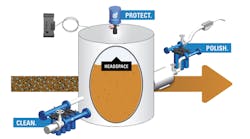Tips to keep your diesel fuel dry this winter
Winter can be challenging for anyone who has ever jumped a battery or pushed a car out of a snowbank. But for diesel fleet operators, cold-weather months can bring a whole new level of stress. With the increasing prevalence of high-pressure common rail (HPCR) engines, fuel that isn’t pristinely clean — free of even microscopic contaminants — can cause unexpected downtime or even costly repairs. And those contaminants include water, dirt, and sludge that form deposits.
When cold temperatures hit, diesel begins to gel, turning from liquid to semi-solid and becoming a significant productivity killer. Temperatures as high as 40 degrees F can negatively impact the performance of No. 2 diesel (summer blend) and biodiesel blends. At these temperatures, diesel typically begins to form wax crystals or start gelling, which leads to plugged fuel filters and poor starting and engine performance.
There’s no one-size-fits-all solution for keeping water out of your diesel during the winter, but there are some actions you can take to protect your fuel and equipment.
Keep your diesel tanks topped off
Fuel systems on newer engines tend to run warmer compared to older series engines and are more prone to condensation in the headspace, the empty area between the fuel level and the top of the tank. One way to mitigate this condensation is to fill your tanks at the end of the day while the engine is still warm.
Clean, protect, and polish your bulk fuel
In addition to proper fuel management in on-board fuel tanks, Donaldson recommends inspecting your bulk tank semi-annually, and especially before cold weather hits. If sediment, gums, and sludge are accumulating in the bottom inch of your tank, have a professional clean the tank. Next, add tools to make sure the accumulation doesn’t happen again. Consider delivery filtration ahead of your bulk tank to prevent off-spec fuel from contaminating your infrastructure. Also, use a tank breather to prevent dirt and moisture from getting into the tank from the atmosphere. As an extra measure, if you have a clean and dry air source, you can use it to prevent condensation from building up inside the tank and stop corrosion in its tracks. Finally, use particle filtration and water absorption on the way out of the bulk tank to ensure you have the cleanest, driest fuel possible. Donaldson calls this whole process the Clean, Protect, and Polish system.
Know your cloud points
Cloud point is the temperature at which the fuel itself starts to form solids as it cools, making the fuel look cloudy. This is also known as gelling or paraffin waxing. Typically, refineries produce diesel seasonally in northern regions that have lower natural cloud points (No. 1 diesel), and southern regions tend to burn diesel with higher natural cloud points all year long (No. 2 diesel). Fuel that is fit for use in warmer climates or purchased in the summer may cause significant cloud point/cold start issues in winter months. Gelling/waxing causes a massive increase in solid particulate loading that leads to rapidly plugging filters. This effect is amplified on modern HPCR engines due to the tighter on-engine filtration needed to keep injectors functioning. Best practices are to use a blend of No. 1 diesel to achieve the appropriate cloud point for your geography. Cold flow improver is a common diesel fuel additive that, when applied correctly, can help to improve winter operability.
Use cold flow improver
Cold flow improver (CFI) additives don’t prevent fuel from gelling and do not change the temperature that solids form in the fuel. They function to reduce the size of the particles formed, making a higher quantity of small particles instead of fewer larger ones. CFIs can be ineffective as they need to be added to warm (50+ degrees F) diesel to blend properly and tend to have issues if water, sludge, or sediment is present in the bulk tanks. As such, an overdosing of CFIs will cause more operability issues. Before adding cold flow improver to your fuel, you need to know its cloud point and if it’s already been treated with CFIs. Large-volume fuel suppliers will likely know the cloud point of the fuel and additives being delivered, so it is important to ask your fuel supplier what you are buying. You can have your fuel tested for cloud point to find out how it will act in cold weather.
Reconsider biodiesel in cold environments
Fleet managers in Canada and many northern regions of the U.S. tend to avoid biodiesel altogether in the winter because of its poor cold-weather performance (cloud point), and even some long-haul southern operations follow suit. This isn’t always possible, however, as it depends on state regulations, some of which mandate the use of biodiesel. Ask your fuel supplier and equipment manufacturer about options and recommendations in your area.
For more information about cold weather operability, visit MyCleanDiesel.com.



